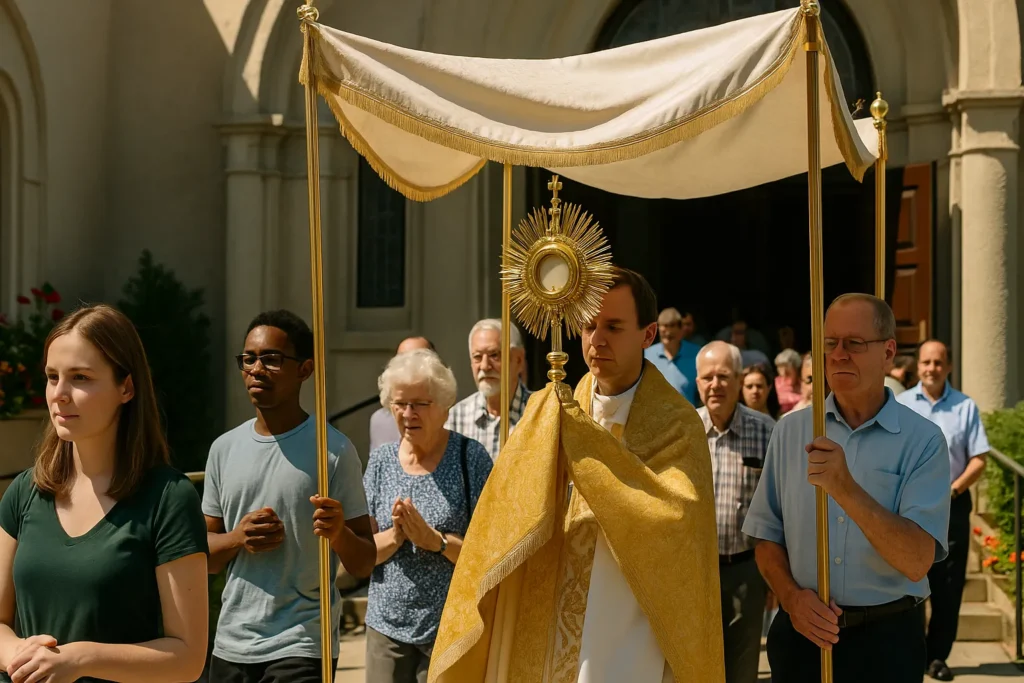Guides, Corpus Christi Day, Holidays
How to Participate in Corpus Christi as a Visitor or New Believer
Whether you’re a curious visitor, a new believer, or someone returning to faith after a long time, attending a Corpus Christi celebration can be an incredibly moving and eye-opening experience.
Marked by solemn Mass, vibrant processions, and heartfelt adoration of the Eucharist, the Solemnity of Corpus Christi — the Feast of the Body and Blood of Christ — invites Catholics around the world to proclaim and honor the real presence of Jesus in the Eucharist.
If you’ve ever wondered, “Can I attend?”, “What do I do?”, or “Will I understand what’s happening?” — this guide is for you.
Let’s walk through how to participate in Corpus Christi with reverence, understanding, and confidence, even if it’s your first time.
What Is Corpus Christi?
Corpus Christi, Latin for “Body of Christ,” is a Catholic feast day that celebrates the belief that Jesus is truly present — body, blood, soul, and divinity — in the Holy Eucharist.
It takes place on the Thursday after Trinity Sunday (or the following Sunday in many countries), usually in late May or June.
The feast includes:
- A special Mass honoring the Eucharist
- A procession through the streets with the Blessed Sacrament
- Communal prayer, song, and sometimes celebration
It’s both a liturgical event and a public act of faith, meant to bring Christ — truly present in the consecrated Host — into the world.
Can I Attend If I’m Not Catholic?
Absolutely.
You are welcome to attend a Corpus Christi Mass or procession as:
- A visitor (curious or cultural)
- A Christian of another denomination
- A non-believer exploring faith
- A catechumen or RCIA candidate
- A new Catholic just learning about the Eucharist
While some elements (like receiving Communion) are reserved for baptized Catholics in a state of grace, your presence, observation, and respectful participation are encouraged.
What to Expect at a Corpus Christi Celebration
1. The Mass
- Focused on the Eucharist, with readings and a homily explaining its significance
- Includes beautiful music, incense, and sometimes Latin or traditional hymns
- Climax is the consecration, where bread and wine become the Body and Blood of Christ
💡 If you’re unfamiliar with the Mass, follow along in a missalette or ask a friend to guide you.
2. The Procession
After Mass, the priest carries the Blessed Sacrament in a monstrance under a canopy, followed by the faithful through city streets or church grounds.
You may see:
- Children scattering flower petals
- Stops at outdoor altars for Gospel readings and blessings
- Singing, candles, banners, and reverent silence
- Kneeling or bowing as the Eucharist passes
3. Post-Procession Prayer or Benediction
The celebration may end with:
- A short prayer or blessing
- Time for personal Eucharistic Adoration
- Community refreshments or social gathering (in some places)
How to Participate Respectfully
If you’re new or unsure, here’s how to join meaningfully:
✅ 1. Dress modestly and neatly
Churches often recommend attire that is clean, comfortable, and respectful — like pants and a shirt or a dress/skirt that covers the shoulders and knees.
✅ 2. Arrive early
It gives you time to find a seat, observe the space, and prepare yourself mentally.
✅ 3. Join in standing, sitting, and kneeling
You can follow what others are doing. Don’t worry if you’re not perfect — just participate with sincerity.
✅ 4. Don’t receive Communion unless you’re a practicing Catholic
Instead, when others go up, you can:
- Stay seated and reflect
- Join the line and cross your arms over your chest to receive a blessing
- Pray silently in gratitude or contemplation
✅ 5. Follow the procession
Even if you don’t fully understand everything, walk quietly, sing if you feel comfortable, and observe the reverence around you.
What Can You Do Beforehand?
🕊️ 1. Learn about the Eucharist
- Read the Last Supper passages in the Gospels (e.g., Luke 22:14–20)
- Look into what Catholics believe about the “real presence”
- Reflect on what it means for Jesus to be truly among us
🪔 2. Talk to a local Catholic friend or priest
Ask them what to expect. Most will be thrilled to help you understand the meaning behind the celebration.
📖 3. Watch a video or read a short guide
Familiar visuals or key terms like “monstrance,” “adoration,” “sacrament,” and “consecration” will help the experience feel less unfamiliar.
Why It Might Move You
Even if you don’t share every belief, Corpus Christi can impact you:
- The beauty and reverence of the procession
- The silence and stillness of Eucharistic adoration
- The sense of unity among hundreds walking together in faith
- The visible expression of invisible truths — light, presence, hope
Many who attend as visitors describe feeling something sacred, peaceful, or deeply human — even without theological understanding.
Final Thought: Just Come and See
You don’t need to be perfect. You don’t need to have all the answers. You don’t need to be Catholic to witness something holy.
Corpus Christi invites everyone to encounter the mystery of faith through beauty, reverence, and community.
So whether you come out of curiosity, tradition, or longing — come with an open heart. Walk with us. Listen. Watch. Pray, if you’d like.
“Come and see.” – John 1:39

